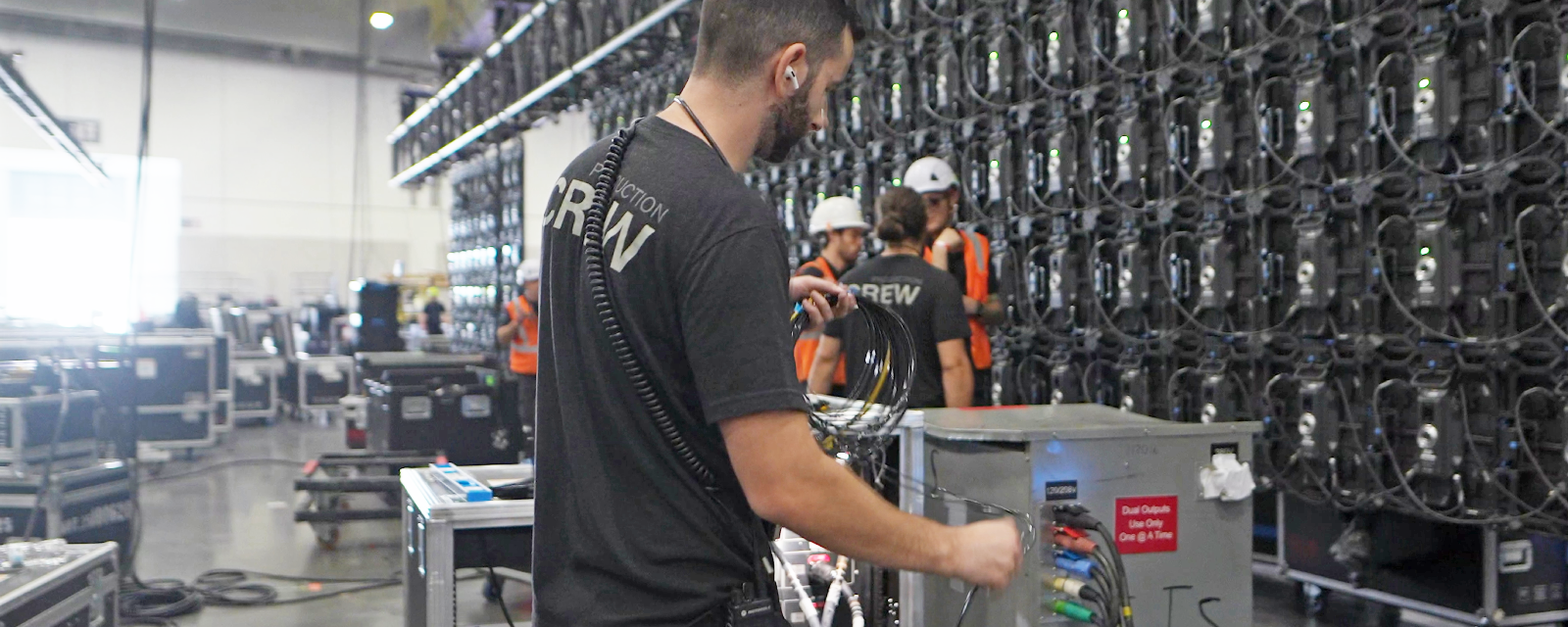Choosing the Right Equipment
How Quality Components Ensure the Success of AV Integration Projects
In the world of audio-visual integration, the components you choose can have a lasting impact on the quality, reliability, and longevity of your system. When AV systems are built with carefully selected, high-quality equipment—such as lighting fixtures, sound systems, LED video displays, special effects, and control interfaces—the experience they create is seamless, engaging, and dependable. However, compromising on equipment quality or choosing incompatible components can lead to budget overruns, reduced system lifespans, and poor user experiences.
Here, we’ll discuss why choosing the right AV equipment is essential and highlight the potential pitfalls of incorrect or low-quality components. We’ll also provide tips for selecting components that will ensure long-term success in AV integration projects.

Trust Fall Technology Group Professional AV Equipment
The Importance of Quality Components in AV Systems
Quality AV components are designed to withstand the rigors of frequent use, environmental stressors, and technical demands. Unlike their lower-quality counterparts, premium components are built for durability, reliability, and optimal performance over the long term. In AV setups—particularly in venues with high traffic or intensive usage, like entertainment spaces or corporate environments—this quality is non-negotiable.
For example, top-tier LED video displays offer higher brightness levels, more vibrant colors, and better energy efficiency, ensuring an immersive experience that doesn’t fade over time. In contrast, lower-quality screens can quickly lose brightness, suffer from pixel burnout, or fail in extreme conditions, requiring more frequent maintenance or replacements. Investing in reliable components minimizes these risks, reducing both downtime and unexpected expenses.
Avoiding the Budget Pitfalls of Incompatible Equipment
AV integrations rely on multiple systems—such as sound reinforcement, lighting, video displays, and control systems—that need to work in harmony. Selecting incompatible or subpar components can create numerous budget and technical problems. For instance, a control system might not be able to handle the load required by high-output lighting fixtures, or low-quality sound equipment may distort or interfere with video components. These incompatibilities often lead to costly troubleshooting and can significantly stretch project budgets.
Incorrect equipment choices can also mean increased energy consumption, frequent breakdowns, and a greater likelihood of system failure—all of which translate to higher operating costs. A high-quality AV setup that includes compatible, energy-efficient components minimizes these issues, providing a more sustainable and budget-friendly solution over time.
Impact on the Lifespan and Reliability of the AV System
The quality of AV components directly influences the lifespan of the entire system. High-grade LED video walls, for example, can last years longer than low-end alternatives and typically offer warranties that protect your investment. Inferior components, on the other hand, may suffer from technical problems like color fading, audio distortion, or control lag within a matter of months. Such failures not only disrupt the user experience but can also necessitate full system replacements well before the expected lifespan, compounding costs significantly.
Furthermore, choosing reliable components reduces the frequency of maintenance, allowing AV teams to focus on enhancing the user experience instead of performing regular repairs. High-quality sound systems, for instance, maintain clarity and power over time, ensuring consistent performance with minimal upkeep.
Ensuring a Seamless Experience with Reliable Special Effects Equipment
For spaces that rely on special effects—such as cryogenics, pyrotechnics, and advanced lighting systems—the right equipment choice is essential for both safety and performance. Special effects require specialized AV components that are safe, efficient, and easily integrated with other systems. Choosing reliable effects equipment reduces the risk of malfunction, which could otherwise lead to accidents, additional liability, and unexpected costs.
When pyrotechnics, for example, are synchronized with lighting or video, any technical issues can disrupt the entire show, affecting audience satisfaction and the venue’s reputation. Reliable equipment minimizes the chances of such mishaps, creating a smoother and safer experience for audiences and technicians alike.
The Role of Control Systems in Integrating and Optimizing AV Components
Control systems are the backbone of any AV setup, integrating all components into a cohesive, easy-to-manage solution. High-quality control systems are essential for streamlining operations and maintaining consistent performance across audio, video, lighting, and special effects components. A robust control system offers intuitive interfaces, flexible programming, and compatibility with other AV devices, making it easy to adjust settings, troubleshoot issues, and maintain seamless synchronization.
Inferior control systems, by contrast, can be prone to lag, system crashes, or limited compatibility, which can lead to interruptions in service and operational inefficiencies. Choosing a reliable, well-matched control system ensures that the AV setup functions as a unified whole, enhancing user experience and simplifying management.
Building a Lasting AV System with the Right Equipment
Choosing the right components for an AV integration project isn’t just about selecting equipment that fits the budget—it’s about investing in quality and compatibility to create an experience that will stand the test of time. High-quality lighting, sound systems, LED displays, special effects equipment, and control systems deliver enhanced reliability, reduced maintenance costs, and a polished experience for end-users.
By investing in quality components from the start, you’re building an AV system that won’t just perform well but will continue to impress audiences and support long-term business goals. In an industry where technology and experience are paramount, choosing the right equipment is the difference between a project that’s merely functional and one that creates lasting impact.
Conclusion
In the AV industry, the equipment you choose sets the foundation for success. High-quality, compatible components ensure that your audio-visual systems deliver exceptional performance, reliability, and longevity. They minimize risks, reduce long-term costs, and provide audiences with experiences that are both immersive and memorable.
By prioritizing quality over shortcuts, you position your projects for lasting success. Whether it’s a state-of-the-art LED display, a crystal-clear sound system, or an intuitive control interface, the right equipment makes all the difference. Invest wisely, and you’ll create AV integrations that not only meet but exceed expectations, standing the test of time and technological advancements.
